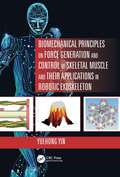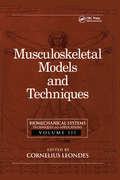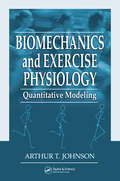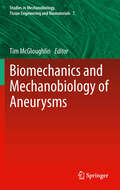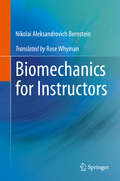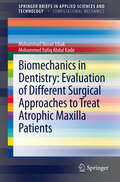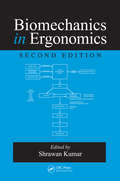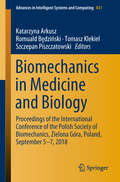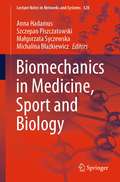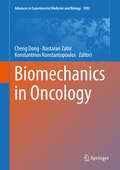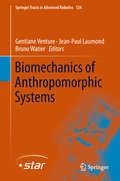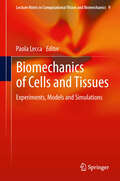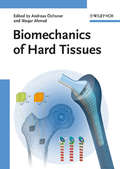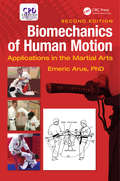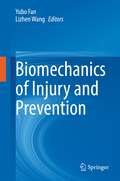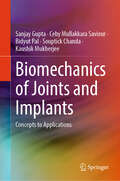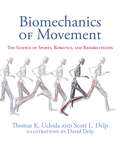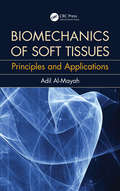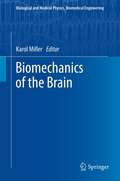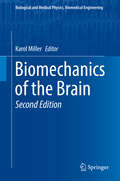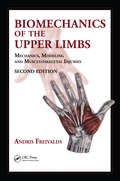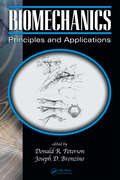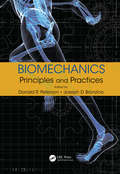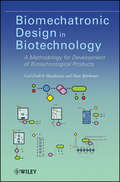- Table View
- List View
Biomechanical Principles on Force Generation and Control of Skeletal Muscle and their Applications in Robotic Exoskeleton (Advances in Systems Science and Engineering (ASSE))
by Yuehong YinThis book systematically introduces the bionic nature of force sensing and control, the biomechanical principle on mechanism of force generation and control of skeletal muscle, and related applications in robotic exoskeleton. The book focuses on three main aspects: muscle force generation principle and biomechanical model, exoskeleton robot technology based on skeletal muscle biomechanical model, and SMA-based bionic skeletal muscle technology. This comprehensive and in-depth book presents the author's research experience and achievements of many years to readers in an effort to promote academic exchanges in this field. About the Author Yuehong Yin received his B.E. , M.S. and Ph.D. degrees from Nanjing University of Aeronautics and Astronautics, Nanjing, in 1990, 1995 and 1997, respectively, all in mechanical engineering. From December 1997 to December 1999, he was a Postdoctoral Fellow with Zhejiang University, Hangzhou, China, where he became an Associate Professor in July 1999. Since December 1999, he has been with the Robotics Institute, Shanghai Jiao Tong University, Shanghai, China, where he became a Professor and a Tenure Professor in December 2005 and January 2016, respectively. His research interests include robotics, force control, exoskeleton robot, molecular motor, artificial limb, robotic assembly, reconfigurable assembly system, and augmented reality. Dr. Yin is a fellow of the International Academy of Production Engineering (CIRP).
Biomechanical Systems: Techniques and Applications, Volume III: Musculoskeletal Models and Techniques
by Cornelius LeondesBecause of developments in powerful computer technology, computational techniques, advances in a wide spectrum of diverse technologies, and other advances coupled with cross disciplinary pursuits between technology and its greatly significant applied implications in human body processes, the field of biomechanics is evolving as a broadly significant area. This Third Volume presents the advances in widely diverse areas with significant implications for human betterment that occur continuously at a high rate. These include dynamics of musculo-skeletal systems; mechanics of hard and soft tissues; mechanics of muscle; mechanics of bone remodeling; mechanics of implant-tissue interfaces; cardiovascular and respiratory biomechanics; mechanics of blood flow, air flow, flow-prosthesis interfaces; mechanics of impact; dynamics of man machine interaction; and numerous other areas. The great breadth and depth of the field of biomechanics on the international scene requires at least four volumes for adequate treatment. These four volumes constitute a well integrated set that can be utilized as individual volumes. They provide a substantively significant and rather comprehensive, in-depth treatment of biomechanic systems and techniques that is most surely unique on the international scene.
Biomechanics
by Cees Oomens Marcel Brekelmans Frank BaaijensThis is the first textbook to integrates both general and specific topics, theoretical background and biomedical engineering applications, as well as analytical and numerical approaches. This quantitative approach integrates the classical concepts of mechanics and computational modelling techniques, in a logical progression through a wide range of fundamental biomechanics principles. Online MATLAB-based software along with examples and problems using biomedical applications will motivate undergraduate biomedical engineering students to practise and test their skills. The book covers topics such as kinematics, equilibrium, stresses and strains, and also focuses on large deformations and rotations and non-linear constitutive equations, including visco-elastic behaviour and the behaviour of long slender fibre-like structures. This is the definitive textbook for students.
Biomechanics and Exercise Physiology: Quantitative Modeling
by Arthur T. JohnsonWhether you are a bioengineer designing prosthetics, an aerospace scientist involved in life support, a kinesiologist training athletes, or an occupational physician prescribing an exercise regimen, you need the latest edition of Biomechanics and Exercise Physiology: Quantitative Modeling. Using numerous worked examples to demonstrate what and when
Biomechanics and Mechanobiology of Aneurysms (Studies in Mechanobiology, Tissue Engineering and Biomaterials #7)
by Tim McgloughlinCardiovascular disease is the leading cause of morbidity and premature death of modern era medicine. It is estimated that approximately 81 million people in the United States (US) currently have one or more of the many forms of cardiovascular disease, resulting in 1 in every 2.8 deaths, or 900,000 deaths per year. 40% of all deaths in Europe are a result of cardiovascular disease in people under the age of 75. Aneurysms form a significant portion of these cardiovascular related deaths and are defined as a permanent and irreversible localised dilation of a blood vessel greater than 50% of its normal diameter. Although aneurysms can form in any blood vessel, the more lethal aneurysms develop in the cranial arteries, and in the thoracic aorta and abdominal aorta. Frequently aneurysms are undetected and if left untreated may eventually expand until rupture with very high levels of morbidity and mortality. The biomechanics and mechanobiology of aneursymal diseases are not fully understood and this monograph aims to provide new insights into aneurysm aetiology and behavior based on the most recent biomechanics research related to this important topic. The contributors to this volume bring together a unique blend of expertise in experimental, computational and tissue biomechanics relating to aneurysm behavior and enable the reader to gain a fresh understanding of key factors influencing aneurysm behavior and treatment. Biological risk factors such as tobacco smoking, sex, age, hypertension, family history and mechanobiological risk factors such as aneurysm geometry and shape as well as mechanical properties of the diseased tissues are considered in detail as are many of the diagnostic and treatment options.
Biomechanics for Instructors
by Nikolai Aleksandrovich BernsteinThis book comprises a series of lectures given by celebrated Soviet neurophysiologist Nikolai Alexandrovich Bernstein in Moscow in 1925 and first published in Russian in 1926. Bernstein’s groundbreaking work, which has had a significant influence on the development of neuroscience, movement studies, and other fields of study in Russia, Eastern Europe, and the West, was suppressed during Stalin’s regime. At the time of its publication, Biomechanics for Instructors was a significant resource for teachers, with its descriptions of the movement of joints and degrees of freedom, illustrations of how to calculate the work capacity of muscles with bones acting as levers, the role of the central nervous system in movement, and more. Though the terminologies and methods have changed and been updated as research and technologies have progressed, the book remains a valuable introduction for those interested in Bernstein’s work more generally, and to those involved in the study of biomechanics. This book is also of interest to historians and philosophers of neuroscience, as well as those involved in movement studies in both the scientific and artistic domains, and to physiotherapists and those involved in sports research and practice.
Biomechanics in Dentistry: Evaluation Of Different Surgical Approaches To Treat Atrophic Maxilla Patients (SpringerBriefs in Applied Sciences and Technology)
by Mohammed Rafiq Abdul Kadir Muhammad Ikman IshakThis book shows computational finite element simulations to analyse the strength of implant anchorage for intrasinus and extramaxillary approaches under various occlusal loading locations and directions. Three-dimensional model of the craniofacial area surrounding the region of interest, soft tissue and framework are developed using computed tomography image datasets. The zygomatic and standard dental implants are modeled using a conventional computer-aided design software and placed at the appropriate location. Material properties are assigned appropriately for the cortical, cancellous bones and implants with Masseter forces applied at the zygomatic arch and occlusal loadings applied on the framework surface.
Biomechanics in Ergonomics
by Shrawan KumarSafety or comfort? Can you truly have one without the other? Is it feasible to have both? Although by no means the only factor, a deep understanding of biomechanics plays a leading role in the design of work and workplaces that are both pain and injury free. Standing firmly on the foundation built by the previous edition, the second edition of Biom
Biomechanics in Medicine and Biology: Proceedings of the International Conference of the Polish Society of Biomechanics, Zielona Góra, Poland, September 5-7, 2018 (Advances in Intelligent Systems and Computing #831)
by Katarzyna Arkusz Romuald Będziński Tomasz Klekiel Szczepan PiszczatowskiThis book presents the proceedings of the “International Conference of the Polish Society of Biomechanics – BIOMECHANICS 2018” held in Zielona Góra, Poland from September 5 to 7, 2018, and discusses recent research on innovations in biomechanics.It includes a collection of selected papers in all key areas of biomechanics, including cellular, molecular, neuro and musculoskeletal biomechanics, as well as sport, clinical and rehabilitation biomechanics. These themes are extremely important in the development of engineering concepts and methods to provide new medical solutions, especially in the context of an ageing population.Presenting the latest technical advances and research methods used in clinical biomechanics, this book is of interest to scientists as well as junior researchers and students of interdisciplinary fields of engineering, medical, and sports sciences.
Biomechanics in Medicine, Sport and Biology (Lecture Notes in Networks and Systems #328)
by Szczepan Piszczatowski Anna Hadamus Małgorzata Syczewska Michalina BłażkiewiczThis book contains fourteen chapters dealing with various aspects of the biomechanics of today. The topics covered are glimpses of what modern biomechanics can offer scientists, students, and the general public. We hope this book can be inspiring, helpful, and interesting for many readers who are not necessarily concerned with biomechanics daily.
Biomechanics in Oncology (Advances in Experimental Medicine and Biology #1092)
by Cheng Dong Nastaran Zahir Konstantinos KonstantopoulosThis book covers multi-scale biomechanics for oncology, ranging from cells and tissues to whole organ. Topics covered include, but not limited to, biomaterials in mechano-oncology, non-invasive imaging techniques, mechanical models of cell migration, cancer cell mechanics, and platelet-based drug delivery for cancer applications. This is an ideal book for graduate students, biomedical engineers, and researchers in the field of mechanobiology and oncology.This book also:Describes how mechanical properties of cancer cells, the extracellular matrix, tumor microenvironment and immuno-editing, and fluid flow dynamics contribute to tumor progression and the metastatic processProvides the latest research on non-invasive imaging, including traction force microscopy and brillouin confocal microscopyIncludes insight into NCIs’ role in supporting biomechanics in oncology researchDetails how biomaterials in mechano-oncology can be used as a means to tune materials to study cancer
Biomechanics of Anthropomorphic Systems (Springer Tracts in Advanced Robotics #124)
by Jean-Paul Laumond Gentiane Venture Bruno WatierMechanical laws of motion were applied very early for better understanding anthropomorphic action as suggested in advance by Newton «For from hence are easily deduced the forces of machines, which are compounded of wheels, pullies, levers, cords, and weights, ascending directly or obliquely, and other mechanical powers; as also the force of the tendons to move the bones of animals». In the 19th century E.J. Marey and E. Muybridge introduced chronophotography to scientifically investigate animal and human movements. They opened the field of motion analysis by being the first scientists to correlate ground reaction forces with kinetics.Despite of the apparent simplicity of a given skilled movement, the organization of the underlying neuro-musculo-skeletal system remains unknown. A reason is the redundancy of the motor system: a given action can be realized by different muscle and joint activity patterns, and the same underlying activity may give rise to several movements. After the pioneering work of N. Bernstein in the 60’s on the existence of motor synergies, numerous researchers «walking on the border» of their disciplines tend to discover laws and principles underlying the human motions and how the brain reduces the redundancy of the system. These synergies represent the fundamental building blocks composing complex movements.In robotics, researchers face the same redundancy and complexity challenges as the researchers in life sciences. This book gathers works of roboticists and researchers in biomechanics in order to promote an interdisciplinary research on anthropomorphic systems at large and on humanoid robotics in particular.
Biomechanics of Cells and Tissues: Experiments, Models and Simulations (Lecture Notes in Computational Vision and Biomechanics #9)
by Paola LeccaThe application of methodological approaches and mathematical formalisms proper to Physics and Engineering to investigate and describe biological processes and design biological structures has led to the development of many disciplines in the context of computational biology and biotechnology. The best known applicative domain is tissue engineering and its branches. Recent domains of interest are in the field of biophysics, e.g.: multiscale mechanics of biological membranes and films and filaments; multiscale mechanics of adhesion; biomolecular motors and force generation. Modern hypotheses, models, and tools are currently emerging and resulting from the convergence of the methods and phylosophycal apporaches of the different research areas and disciplines. All these emerging approaches share the purpose of disentangling the complexity of organisms, tissues, and cells and mimiking the function of living systems. The contributions presented in this book are current research highlights of six challenging and representative applicative domains of phyisical, engineering, and computational approaches in medicine and biology, i.e tissue engineering, modelling of molecular structures, cell mechanics and cell adhesión processes, cancer physics, and physico-chemical processes of metabolic interactions. Each chapter presents a compendium or a review of the original results achieved by authors in the last years. Furthermore, the book also wants to pinpoint the questions that are still open and that could propel the future research.
Biomechanics of Hard Tissues: Modeling, Testing, and Materials
by Andreas Öchsner Waqar AhmedThis monograph assembles expert knowledge on the latest biomechanical modeling and testing of hard tissues, coupled with a concise introduction to the structural and physical properties of bone and cartilage. A strong focus lies on the current advances in understanding bone structure and function from a materials science perspective, providing practical knowledge on how to model, simulate and predict the mechanical behavior of bone. The book presents directly applicable methods for designing and testing the performance of artificial bones and joint replacements, while addressing innovative and safe approaches to stimulated bone regeneration essential for clinical researchers.
Biomechanics of Human Motion: Applications in the Martial Arts, Second Edition
by Emeric Arus, Ph.D.This book covers the general laws governing human biomechanics through an extensive review of martial arts techniques and references to fundamental theory. Using straightforward mathematics and physics, this work covers indepth the anatomical foundation of biomechanics and physiological foundation of human motion through specific and relevant martial arts applications. This book also covers the kinematics and kinetics of biomechanics via examples from martial arts and their comparison to different sports techniques. It is written to be used and referenced by biomechanical professionals and martial arts enthusiasts.
Biomechanics of Injury and Prevention
by Yubo Fan Lizhen WangThis book summarizes the recent advancements for biomechanics of injury and prevention in mechanism, application and developing frontiers. Biomechanics plays an important role in achieving safety, health, comfort, and a high quality of life by revealing injury mechanism and providing prevention methods. The book covers injury and prevention to the entire human body, from head to toe, including injury and prevention in sports, traffic, accident, clinic and so on. In addition, bionics prevention method inspired by woodpecker is also introduced. The book provides the reader with not only the mechanism of injury but also the advanced injury diagnosis, treatment, and prevention devices based on biomechanics.
Biomechanics of Joints and Implants: Concepts to Applications
by Sanjay Gupta Ceby Mullakkara Saviour Bidyut Pal Souptick Chanda Kaushik MukherjeeThis textbook serves as a comprehensive resource for readers interested in applying the principles of engineering mechanics to analyse the mechanical and structural functions of the musculoskeletal system. Over the past few decades, orthopaedic practice has strongly been influenced by the contributions from mechanical analysis and design. This book sequentially presents basic concepts and applications necessary for understanding a biomechanical system. The book is specially focussed on analysis and design of orthopaedic implants used to treat skeletal diseases and disorders. The book begins with an introduction to the anatomy, physiology, and movements of human body and its mechanical analogy, followed by chapters on basic biomechanics of various joints and spine. It elaborately discusses the gait analysis and measurement techniques and systematically presents the quantitative estimation of musculoskeletal forces (joint forces and moments, muscle forces) using the fundamental concepts of joint dynamics (kinematics and kinetics), with relevant solved examples and exercises to impart basic understanding and knowledge to the students. It also discusses the basic concepts of mechanics of deformable bodies relevant for bone tissue as well as implanted bone structure, common failure mechanisms of implanted bone structure and biomaterials used in orthopaedic implants, and the steps involved in finite element modelling and analysis of implant-bone structures. Other topics covered include various theories, mathematical formulations, the computational framework of bone remodelling and bone ingrowth, mechanobiology based mathematical models of tissue differentiation, and simulations on tissue ingrowth have been presented along with the outcomes of our research activities, which may help and inspire the students to pursue research in this field.
Biomechanics of Movement: The Science of Sports, Robotics, and Rehabilitation
by Thomas K. Uchida Scott L DelpAn engaging introduction to human and animal movement seen through the lens of mechanics.How do Olympic sprinters run so fast? Why do astronauts adopt a bounding gait on the moon? How do running shoes improve performance while preventing injuries? This engaging and generously illustrated book answers these questions by examining human and animal movement through the lens of mechanics. The authors present simple conceptual models to study walking and running and apply mechanical principles to a range of interesting examples. They explore the biology of how movement is produced, examining the structure of a muscle down to its microscopic force-generating motors. Drawing on their deep expertise, the authors describe how to create simulations that provide insight into muscle coordination during walking and running, suggest treatments to improve function following injury, and help design devices that enhance human performance.
Biomechanics of Soft Tissues: Principles and Applications
by Adil Al MayahThe emerging paradigm of incorporating images and biomechanical properties of soft tissues has proven to be an integral part of the advancement of several medical applications, including image guided radiotherapy and surgery, brachytherapy, and diagnostics. This expansion has resulted in a growing community of medical, science, and engineering professionals applying mechanical principles to address medical concerns. This book is tailored to cover a range of mechanical principles, properties, and applications of soft tissues that have previously been addressed in various journals and "anatomical site-specific" books. Biomechanics of Soft Tissues follows a different approach by offering a simplified overview of widely used mechanical models and measuring techniques of soft tissue parameters. This is followed by an investigation of different medical applications, including: biomechanical aspects of cancerous tumor progressions, radiotherapy treatment, and image guided ultrasound guided interventions. Written by leading scholars and professionals in the field, Biomechanics of Soft Tissues combines engineering and medical expertise, thereby producing an excellent source of information for professionals interested in the theoretical and technological advancements related to soft tissues. The book provides medical professionals with an insight on various modeling approaches, testing techniques, and mechanical characteristics that are frequently used by engineers. Conversely, the presented medical applications provide engineers with a glimpse of amazing medical practices and encourage them to expand their roles in the medical field. Provides a simplified overview of mechanics of soft tissues. Highlights different techniques to measure tissues properties for engineering and medical applications. Contains novel ideas to address roles of mechanics in disease progression and treatment. Presents innovative applications of biomechanics in medical procedures.
Biomechanics of the Brain (Biological and Medical Physics, Biomedical Engineering)
by Karol MillerBiomechanics of the Brain will present an introduction to brain anatomy for engineers and scientists. Experimental techniques such as brain imaging and brain tissue mechanical property measurement will be discussed, as well as computational methods for neuroimage analysis and modeling of brain deformations due to impacts and neurosurgical interventions. Brain trauma between the different sexes will be analyzed. Applications will include prevention and diagnosis of traumatic injuries, such as shaken baby syndrome, neurosurgical simulation and neurosurgical guidance, as well as brain structural disease modeling for diagnosis and prognosis. This book will be the first book on brain biomechanics. It will provide a comprehensive source of information on this important field for students, researchers, and medical professionals in the fields of computer-aided neurosurgery, head injury, and basic biomechanics.
Biomechanics of the Brain (Biological and Medical Physics, Biomedical Engineering)
by Karol MillerThis new edition presents an authoritative account of the current state of brain biomechanics research for engineers, scientists and medical professionals. Since the first edition in 2011, this topic has unquestionably entered into the mainstream of biomechanical research. The book brings together leading scientists in the diverse fields of anatomy, neuroimaging, image-guided neurosurgery, brain injury, solid and fluid mechanics, mathematical modelling and computer simulation to paint an inclusive picture of the rapidly evolving field.Covering topics from brain anatomy and imaging to sophisticated methods of modeling brain injury and neurosurgery (including the most recent applications of biomechanics to treat epilepsy), to the cutting edge methods in analyzing cerebrospinal fluid and blood flow, this book is the comprehensive reference in the field. Experienced researchers as well as students will find this book useful.
Biomechanics of the Upper Limbs: Mechanics, Modeling and Musculoskeletal Injuries, Second Edition
by Andris FreivaldsThere is already a wealth of literature covering cumulative trauma disorders and medical management, as well as the biomechanics of manual material handling and lower back problems. However, despite a spike in the number of work-related musculoskeletal disorders (WRMSDs) in the upper limbs-due to a sharp increase in the amount of computer-related j
Biomechanics: Principles and Applications, Second Edition
by Joseph D. Bronzino Donald R. PetersonTraditionally, applications of biomechanics will model system-level aspects of the human body. As a result, the majority of technological progress to date appears in system-level device development. More recently, biomechanical initiatives are investigating biological sub-systems such as tissues, cells, and molecules. Fueled by advances in experime
Biomechanics: Principles and Practices
by Joseph D. Bronzino Donald R. PetersonThis book draws on material from the biomechanics section of The Biomedical Engineering Handbook, Fourth Edition, and includes additional chapters containing highly relevant, cutting-edge material dealing with cellular mechanics. Edited by Donald R. Peterson and Joseph D. Bronzino, it brings together contributions by world-class experts in the field. Offering an overview of major research topics in biomechanics, this is a useful resource for practitioners, scientists, and researchers in biomechanics, as well as biomedical engineering graduate students studying biomechanics, biodynamics, human performance engineering, and human factors.
Biomechatronic Design in Biotechnology
by Carl-Fredrik Mandenius Mats Björkman". . . a must-read for all modern bio-scientists and engineers working in the field of biotechnology. " - Biotechnology Journal, 2012, 7 A cutting-edge guide on the fundamentals, theory, and applications of biomechatronic design principles Biomechatronic Design in Biotechnology presents a complete methodology of biomechatronics, an emerging variant of the mechatronics field that marries biology, electronics, and mechanics to create products where biological and biochemical, technical, human, management-and-goal, and information systems are combined and integrated in order to solve a mission that fulfills a human need. A biomechatronic product includes a biological, mechanical, and electronic part. Beginning with an overview of the fundamentals and theory behind biomechatronic technology, this book describes how general engineering design science theory can be applied when designing a technical system where biological species or components are integrated. Some research methods explored include schemes and matrices for analyzing the functionality of the designed products, ranking methods for screening and scoring the best design solutions, and structuring graphical tools for a thorough investigation of the subsystems and sub-functions of products. This insightful guide also: Discusses tools for creating shorter development times, thereby reducing the need for prototype testing and verification Presents case study-like examples of the technology used such as a surface plasmon resonance sensor and a robotic cell culturing system for human embryonic stem cells Provides an interdisciplinary and unifying approach of the many fields of engineering and biotechnology used in biomechatronic design By combining designs between traditional electronic and mechanical subsystems and biological systems, this book demonstrates how biotechnology and bioengineering design can utilize and benefit from commonly used design tools-- and benefit humanity itself.
